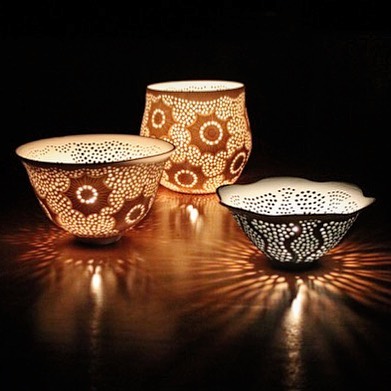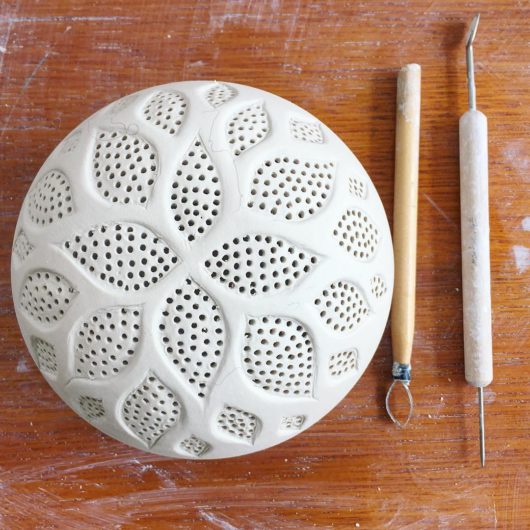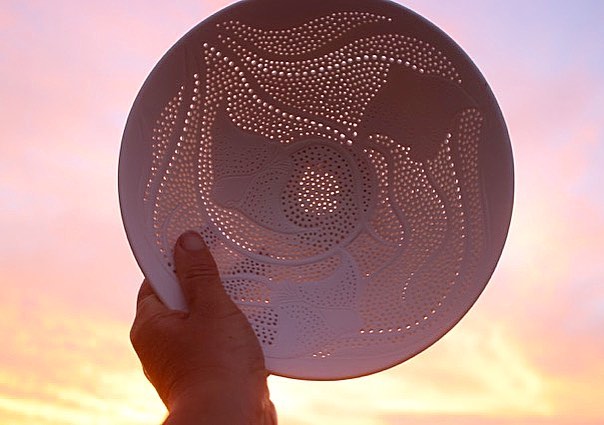Dariya Gratte produces beautifully intricate ceramics that double as both functional pieces and stunning artworks.
Margaret River Open Studios is back for another year of art-filled studios, workshops and homes. We chat to one of the 2019 artists, Dariya Gratte, about her incredibly detailed ceramic works, and where we can find them during this Open Studios.
FQ: I believe your background is painting – how did you get into the world of ceramics?
DG: Yes, I studied at Claremont Art School, majoring in painting. After completing my studies I moved to Margaret River and fell in love with the beautiful coastline and forests. One of the local potteries was looking for someone who could help in their busy workshop and offered me a traineeship. I was taught to use Japanese brushes to paint designs, using oxides and stains, onto unfired pots. On my breaks I used to watch the potters turn huge balls of clay into magnificent shapes – I decided then I was going to learn how to throw. After many years of practise, I taught myself the art of wheel throwing.
FQ: How do you create your beautifully intricate works?
DG: Most of my ceramics are formed from fine porcelain on a potter’s wheel. I like to create simple shapes with beautiful curves. I like to make each shape a little different, but usually have an idea in mind before starting. Porcelain is challenging clay to work, as it tends to slump and warp easily as the particles are so fine. It has a smooth buttery feel and worth the challenge. No other clay has the same beautiful translucent qualities.
FQ: Your ceramics are renowned for the incredibly detailed patterns etched, carved and cut into their surfaces.
DG: The patterns I use are probably the most important part of the process for me. I am really drawn to pattern and light and endeavour to bring these qualities into my work. Most of the techniques I use originate from ancient Japanese and Korean ceramics, such as Mishima and Nerkomi. Mishima is a technique of inlaying slip under glaze, or even clay into a contrasting clay body – the main clay body of the pottery piece. This technique allows for extremely fine, intricate design work that can be difficult to reliably replicate in any other way. I etch, carve, pierce and cut, with a sharp blade, each pot to create intricate patterns and details, often combining all these techniques onto a single pot.
FQ: Creating such detailed ceramic work looks and sounds quite challenging.
DG: It is a challenging process, which requires a ton of patience. Porcelain is prone to cracking and has to be dried very slowly. The critical time is when the clay is almost dry – it becomes very brittle and it’s when tiny cracks can start to form. Often they are not seen until the pot is fired. And then there is clumsiness, which I can only blame myself for.
FQ: What inspires your works?
DG: I am so very fortunate to live in the coast town of Gnarabup. My day starts rain, hail or shine, with a walk on the beach. The light on the water, the colours in the sky, beautifully patterned shells; to be immersed in nature, I find inspirational. Recently I travelled to the beautiful Indonesian island of Rote. I was really taken by the beautifully coloured starfish and intricately patterned coral, which I have tried to mimic in my latest collection.
FQ: Where will people find you during Margaret River Region Open Studios this year?
DG: I will be working in the beautiful shady courtyard at Payet Gallery, on techniques such as hand craving, Mishima (layering and inlaying slips and glazes) and Nerkomi (using coloured clay). Nicholas and Francois Payet will be working in their purpose-built jewellery gallery and workshop on the most exquisite jewellery you will ever see. We are really looking forward to the event, showing our new creations and talking to interested passers by.
Visit Daria Gratte
@dariya.ceramics
Margaret River Region Open Studios
@margaretriveropenstudios








